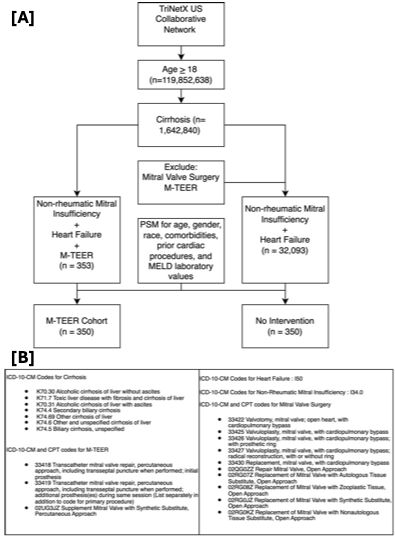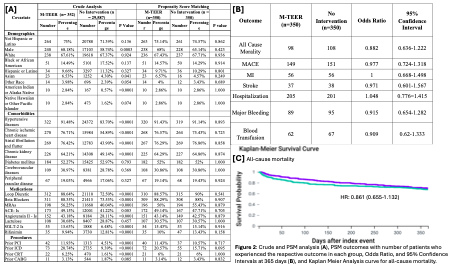Sunday Poster Session
Category: Liver
P1522 - Do Cirrhotic Patients with Subsequent Heart Failure Benefit from Transcatheter Edge to Edge Mitral Valve Repair: A Global TriNetX Cohort
Sunday, October 26, 2025
3:30 PM - 7:00 PM PDT
Location: Exhibit Hall

Amber Hussain, MD
University Hospitals Cleveland Medical Center
Cleveland, OH
Presenting Author(s)
Amber Hussain, MD, Yusef Saeed, MD, Zaid Sharhori, MD
University Hospitals Cleveland Medical Center, Cleveland, OH
Introduction: Transcatheter Edge-to-Edge Repair of the Mitral Valve (M-TEER) is a novel treatment for mitral regurgitation (MR) which has been demonstrated to be safe and efficacious in high risk surgical patients. Patients with cirrhosis and heart failure (HF) who develop MR often have prohibitive surgical risk. This study seeks to elucidate the efficacy of M-TEER in this population.
Methods: The TriNetX US Collaborative Network was used to query patients > 18 with cirrhosis (n=1,642,840) as shown in Figure 1A. From this sample, two cohorts were created: those with cirrhosis followed by HF, MR, and M-TEER (n=353) and those with cirrhosis followed by HF and MR, who did not receive mitral valve surgery or M-TEER (n=32,093). The respective coding for these diagnoses is shown in Figure 1B. Gender, race, diagnoses, and prior cardiac procedures were selected and subjected to propensity score matching (PSM). PSM was also performed on following covariates: age, sodium, creatinine, INR, and total bilirubin. At 12 months follow up, the following outcomes were assessed: all-cause mortality, major adverse cardiac events (MACE), myocardial infarction (MI), stroke, major bleeding, and blood transfusion. MACE was defined by the ICD codes for the following: acute MI, subsequent ST elevation and non ST elevation MI, nontraumatic subarachnoid hemorrhage, nontraumatic intracerebral hemorrhage, other and unspecified nontraumatic intracranial hemorrhage, cerebral infarction, and deceased.
Results: After PSM analysis, 350 patients were present in each cohorts as shown in Figure 2A. As shown in Figure 2B, there was no significant difference in odds ratio for the pre-specified outcomes. Interestingly, a Kaplan-Meier Analysis of all-cause mortality suggests a trend towards decreased mortality in the M-TEER group within the first few months post-procedurally, but does not reach significance (Figure 2C: green line representing M-TEER cohort and purple line representing No Intervention cohort).
Discussion: Patients with cirrhosis who develop HF and MR do not appear to have any difference in mortality, cardiac endpoints, or hospitalization at 1 year following M-TEER, as compared to those with no intervention. Importantly, quality of life metrics and cardiac specific hospitalizations are not included in the analysis. Notably this study contrasts with recent large randomized studies investigating M-TEER. As such, the results should be taken with caution as the study is limited by its retrospective nature and reliance on coding.

Figure: Flowsheet of inclusion and exclusion criteria with relevant coding

Figure: Crude and PSM analysis (A), PSM outcomes with number of patients who experienced the retrospective outcome in each group, Odds Ratio and 95% Confidence Interval at 365 days (B), and Kaplan Meier Analysis curve for all-cause mortality (C)
Disclosures:
Amber Hussain indicated no relevant financial relationships.
Yusef Saeed indicated no relevant financial relationships.
Zaid Sharhori indicated no relevant financial relationships.
Amber Hussain, MD, Yusef Saeed, MD, Zaid Sharhori, MD. P1522 - Do Cirrhotic Patients with Subsequent Heart Failure Benefit from Transcatheter Edge to Edge Mitral Valve Repair: A Global TriNetX Cohort, ACG 2025 Annual Scientific Meeting Abstracts. Phoenix, AZ: American College of Gastroenterology.
University Hospitals Cleveland Medical Center, Cleveland, OH
Introduction: Transcatheter Edge-to-Edge Repair of the Mitral Valve (M-TEER) is a novel treatment for mitral regurgitation (MR) which has been demonstrated to be safe and efficacious in high risk surgical patients. Patients with cirrhosis and heart failure (HF) who develop MR often have prohibitive surgical risk. This study seeks to elucidate the efficacy of M-TEER in this population.
Methods: The TriNetX US Collaborative Network was used to query patients > 18 with cirrhosis (n=1,642,840) as shown in Figure 1A. From this sample, two cohorts were created: those with cirrhosis followed by HF, MR, and M-TEER (n=353) and those with cirrhosis followed by HF and MR, who did not receive mitral valve surgery or M-TEER (n=32,093). The respective coding for these diagnoses is shown in Figure 1B. Gender, race, diagnoses, and prior cardiac procedures were selected and subjected to propensity score matching (PSM). PSM was also performed on following covariates: age, sodium, creatinine, INR, and total bilirubin. At 12 months follow up, the following outcomes were assessed: all-cause mortality, major adverse cardiac events (MACE), myocardial infarction (MI), stroke, major bleeding, and blood transfusion. MACE was defined by the ICD codes for the following: acute MI, subsequent ST elevation and non ST elevation MI, nontraumatic subarachnoid hemorrhage, nontraumatic intracerebral hemorrhage, other and unspecified nontraumatic intracranial hemorrhage, cerebral infarction, and deceased.
Results: After PSM analysis, 350 patients were present in each cohorts as shown in Figure 2A. As shown in Figure 2B, there was no significant difference in odds ratio for the pre-specified outcomes. Interestingly, a Kaplan-Meier Analysis of all-cause mortality suggests a trend towards decreased mortality in the M-TEER group within the first few months post-procedurally, but does not reach significance (Figure 2C: green line representing M-TEER cohort and purple line representing No Intervention cohort).
Discussion: Patients with cirrhosis who develop HF and MR do not appear to have any difference in mortality, cardiac endpoints, or hospitalization at 1 year following M-TEER, as compared to those with no intervention. Importantly, quality of life metrics and cardiac specific hospitalizations are not included in the analysis. Notably this study contrasts with recent large randomized studies investigating M-TEER. As such, the results should be taken with caution as the study is limited by its retrospective nature and reliance on coding.

Figure: Flowsheet of inclusion and exclusion criteria with relevant coding

Figure: Crude and PSM analysis (A), PSM outcomes with number of patients who experienced the retrospective outcome in each group, Odds Ratio and 95% Confidence Interval at 365 days (B), and Kaplan Meier Analysis curve for all-cause mortality (C)
Disclosures:
Amber Hussain indicated no relevant financial relationships.
Yusef Saeed indicated no relevant financial relationships.
Zaid Sharhori indicated no relevant financial relationships.
Amber Hussain, MD, Yusef Saeed, MD, Zaid Sharhori, MD. P1522 - Do Cirrhotic Patients with Subsequent Heart Failure Benefit from Transcatheter Edge to Edge Mitral Valve Repair: A Global TriNetX Cohort, ACG 2025 Annual Scientific Meeting Abstracts. Phoenix, AZ: American College of Gastroenterology.
